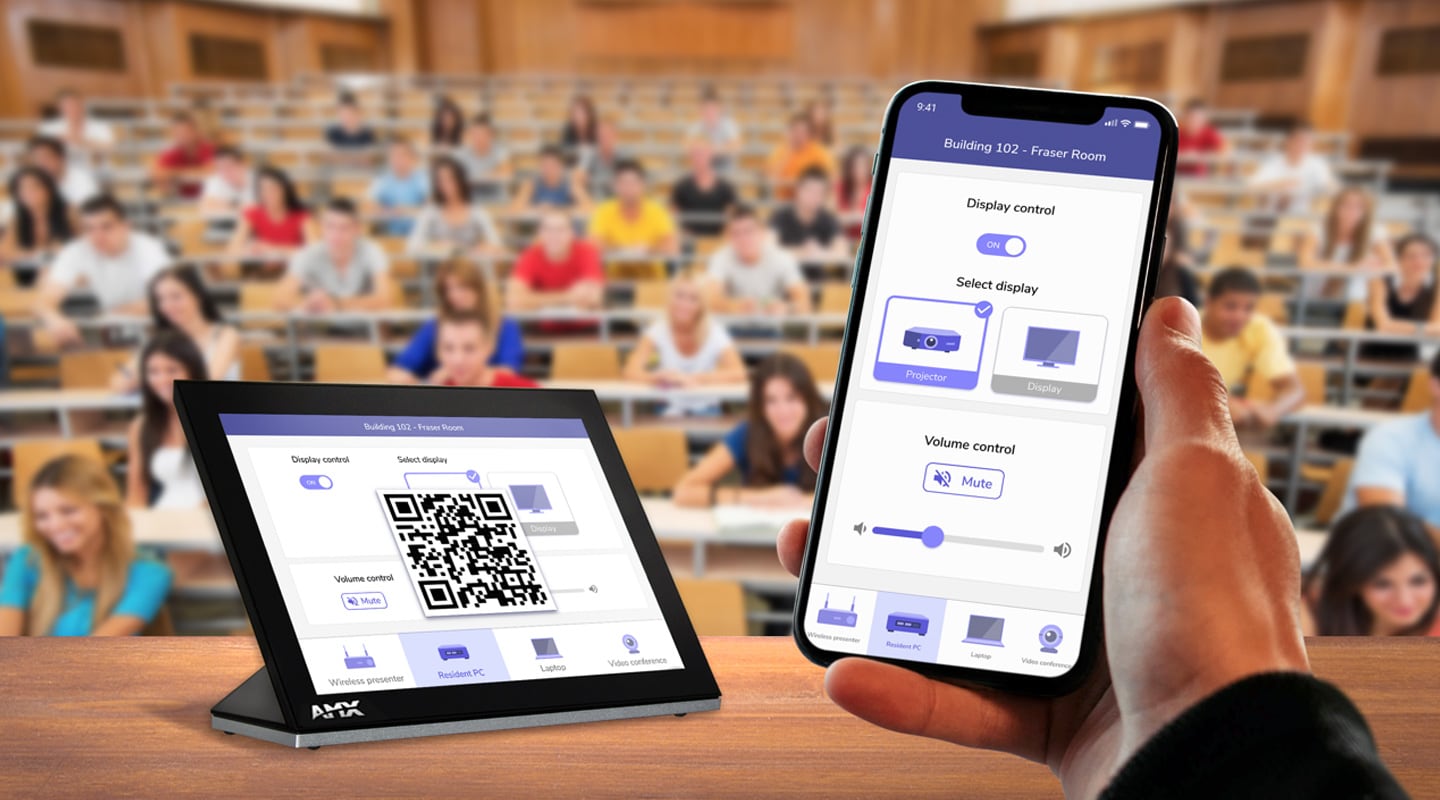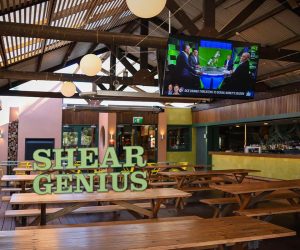
Out of Touch
Touchscreens are a touchy subject. What are the alternatives in a post-COVID world.
Text:/ Derek Powell
If the pandemic has taught us anything about doing business post-Covid it must be that we all need to be nimble in responding to customers’ changing needs. Suddenly, our beloved touchscreens have themselves become a touchy subject. So how do we provide socially-distanced room control? AV Asia Pacific fingers two of the industry’s leading touchscreen exponents and asks: what now… and what’s next?
As workplaces, schools and universities start to slowly come back to life after lockdown, users are increasingly wary of once familiar routines. Elbow bumps have replaced handshakes and every button push is now a trigger for yet more hand sanitising. As people learn more about disease vectors, touchscreens of any sort are understandably causing concern.
Some manufacturers have responded quickly to protect treasured product lines. BenQ for one has just announced its latest model of classroom interactive flat panel features its “Third Generation of Germ-Resistant Screen” for which it claims “longer-lasting anti-bacterial efficacy than any conventional germ-resistant screen or spray on the market.” It’s an important step in maintaining confidence in these widely used collaboration tools but widespread user feedback indicates that customers are still nervous of pressing and swiping on any communal surface.
DEMAND FOR NO TOUCH
A check with industry reveals customers are indeed seeking safer alternatives for their existing and planned audiovisual systems and touchscreens are on the top of their hit list. Graham Barrett, Manager, Strategic Partnerships, Australia for Harman Professional Solutions, has lived and breathed AMX touch panels for decades and naturally has his finger on the pulse of customer concerns. “It’s very much a hot topic at the moment and you’d be surprised how many conversations I’ve had,” he revealed. “It is particularly something that universities are exploring at the moment. They’re all being asked to provide a solution for returning to teaching. Many academics don’t want to touch anything in the room, so how do we give them a solution to be able to turn systems on and take care of basic functionality?”
Over at rivals Crestron, they are very much on the same page, though Jess Warnock, Crestron’s Product Marketing Manager for ANZ, reports corporate clients are also key drivers of the ‘no-touch’ movement. “It is coming from all angles,” he notes. “We are certainly seeing it in the corporate space with social distancing and how many people can be in a room but certainly education, government, consultants: all of these different sectors are thinking about these issues and how they are going to address them.”
Warnock went further, noting that the UC world, given the growth of Zoom and Microsoft Teams rooms, were on the vanguard of a low touch or no touch control movement. “We were already down to a point where most people wanted at least a low touch setup to join a meeting. So that’s been ticking away for quite some time.”
"Many academics don’t want to touch anything in the room, so how do we give them a solution to be able to turn systems on and take care of basic functionality?"
AND IN THE BLUE CORNER
But what are the alternatives and what might a ‘no-touch’ future look like for audiovisual systems? It is a crucial question because, let’s face it, no control technology has been so flexible, updatable useable and reliable as the ubiquitous touchscreen. We put the two industry heavyweights head to head — Crestron in the blue corner and AMX in the white corner — to look at what is on offer right now (and where the limitations are), as well as having them both give us a preview of what’s on the horizon.
As Round 1 starts, Crestron, from the blue corner, is quick to point out that it’s easy to create a huddle space that actually runs itself without any buttons to press.
“In the simplest [Crestron] form,” Jess Warnock says, “that would be an AirMedia 200 or 300 installed behind a display along with one of our POE occupancy sensors. The AirMedia is simply paired with the sensor and controls the display automatically based on occupancy. The entire system can be configured out of the box via a web UI. You set up the occupancy sensitivity and away you go. So it’s really an out-of-the-box room that just runs itself — turning the screen on and facilitating the wireless presentation piece — so I can use AirPlay, MiraCast or the Crestron Sender application to present straight to that screen.”
It is a winning trick and although you could set up a similar no-touch huddle space using AMX, Extron or any other control system, Crestron have it nailed for simplicity with just two components (plus the display) and no specialised programming.
AND IN THE WHITE CORNER
Most audiovisual systems are more complex than a huddle space and so a simple setup switched on by a proximity sensor won’t give us volume control, source selection, lighting and blinds adjustments or any other facilities that we expect from a touch panel. However, today, nearly everyone carries a very capable touch control interface around in their pocket — their personal smartphone. If that could connect to a room control system, we would have a controller that didn’t require users to touch the public touch panel at all. This is the very system that Graham Barrett, springing from the white corner at the start of Round 2, is keen to highlight as the centrepiece of the AMX no-touch solution.
“This concept of control from your personal device, be that a phone or a tablet or whatever, has been part of the product set for 10 or 11 years,” he explained. “We have an external partner in touchpanelcontrol, which has developed a range of applications for us. The most recent iteration is TP Control BYOD. That solution flips the licensing so that the control system has the licence rather than the user’s phone or tablet having the licence. So that allows you to have a QR code (or barcode or some form web address) displayed in the room. The user goes in; scans that QR code; and a version of the touch panel is delivered out to that user’s personal device.”
“That can be a direct replication of the touch panel in the room. It can be a mobile version with different layouts, maybe larger buttons or maybe less buttons, for example. Or, as a short term measure, it can literally be a replacement for the touch panel. So it’s certainly something that a lot of universities are exploring. It’s a very, very simple uplift to an existing system. You don’t have to reprogram the room. It’s really just an adjunct to the existing AMX systems.”
LOOK MA NO WIFI
Crestron, of course is also well on top of BYOD no-touch and have a number of solutions for leveraging external control. But now they are about to return fire with a new concept, which it says avoids some of the issues with WiFi control, by using your phone’s Bluetooth.
“We’re releasing something that is unique to Crestron in this mobile world — a new room control app that takes an entirely different approach!” enthused Jess Warnock. He explains that Crestron is looking to avoid any potential security issues they say could arise by using the network, directly or via the internet, to control an existing audiovisual system.
Jess goes on: “The current Crestron lineup of touch panels has built-in Bluetooth capability. This allows us to map some generic controls from the new Crestron phone app through to the controls programmed on your control system touchscreen. So if I have power, source selection, or any other function programmed into my touch panel, I can access them from my own app, via Bluetooth connectivity to the panels. I don’t have to be on the same network, all I need to do is be within proximity of that panel.
“So it is pretty clever in that, if you’re in the room, you can simply connect and start controlling the system. When you leave the room, it will automatically disconnect. This prevents users from taking control of rooms they are not actually in [reducing the potential for mischief via WiFi]. The user chooses a simplified subset of commands and maps them directly to the existing room controls. No reprogramming required.”
IN THE THIRD (Q-SYS) CORNER
Greg Mattson, Product Manager, Q-SYS Control provides the QSC perspective:
QSC understands the importance and need to create touchless environments in a number of installations – particularly in higher ed and corporate applications. As a software-based audio, video and control system, Q-SYS enables integrators to easily adjust with several new tools to help AV tech admins and integrators quickly implement these system changes, and deliver a meeting space where end users can be productive and feel safe.
With sample Q-SYS design files featuring built-in social distancing control logic, integrators can easily implement a touch-free work environment. These design files also have built-in safety timers and audio reminders to remind users to clean or reset the room at the end of each meeting, as well as utilising room sensors to wake up the touchscreen when someone walks into a room to avoid users touching the display. Combined with the use of Q-SYS Dynamic Ide Screen functionality in Q-SYS NV Series network video endpoints, these files allow custom messages to appear on screen at the beginning of each meeting touting safety protocols, or instructions on how to use the QR code functionality. We have also made a number of high-res templates available for integrators to utilise. In addition, QSC offers a free Q-SYS UCI QR Code plug-in that allows integrators to build direct links to the relevant UCI pages and deploy as a QR code on existing Q-SYS touchscreen devices. From there, users need only aim their phone’s camera at these special QR codes, and the smartphone will automatically open the room’s predetermined controls through the Q-SYS control app or standard mobile web browser.
QSC: www.qsc.com
Technical Audio Group: www.tag.com
VOICE CONTROL
So the judges would have trouble picking a winner in Round 2. Of course, the elephant in the room is voice control: something that is already going hard in the residential market but has yet to make an impact in meeting room or educational control systems. As the bell rings for the final round Jess Warnock metaphorically put his finger (no pun intended) on one key barrier.
“One thing the voice providers haven’t quite nailed yet is making it easy for people to say their commands the way they want to say them,” Jess opined. “There’s a Crestron skill as part of the Alexa kit as well as options for Google Assistant and Josh.ai. We certainly have the capacity to do voice control of Crestron systems today.
“The bigger requirement for something like Alexa in a room is that users need to know what to say. Get it right, then of course it works but it’s certainly not at a place where you can just say whatever you want, and the room will operate. It has to be very specific. There are a number of elegant ways to overcome this using the in-room Crestron technologies. For example, the touch panel or in-room display can be used to present a guided voice control experience.
“With careful consideration of user workflows, system design, and programming, effective voice control can be achieved. The integration is actually quite simple, it’s more about guiding users to say the right thing at this point.”
HARMAN VOCAL RESPONSE
Jess is right of course, Alexa, Google and others do have their semantic limitations. But AMX might have a winning coach in its corner, as heavyweight champion Harman has been working hard on applying voice control in markets such as hospitality using quite different voice-enabled AI.
“Harman is very active in voice,” Graham revealed. “And we have a team working on the next-generation user interfaces, leveraging voice. You can already see those technologies which will be leveraged across our automotive and lifestyle divisions. We’ve shown prototypes as recently as late last year on a platform we’re developing for hotel rooms.”
Using the Houndify voice AI platform from partners SoundHound and its own JBL bluetooth professional speakers, Harman is targeting voice control in hotel rooms, which integrates not just with the internet, but with all of the services within the hotel. ‘Hey Hotel, what time does the gym close?’ ‘Hey, Hotel, turn on the television and select Channel 3’.
“We actually ran a proof of concept with that solution and that’s where we see potential,” Barrett continued. “So certainly the technology is extremely mature within Harman. The hotel room is the first and most applicable solution that we see. But this is a front end to an AMX control system. So that AMX control system could be in a meeting room; it could be in a teaching space; it could be in a boardroom.”
WINNERS
As the final bell rings, who is the winner in our no-touch heavyweight bout? We all are, actually. One of the few positives that COVID might yet bring in its wake is the greatest leap forward in control and convenience since the touch panel itself.
"if you’re in the room, you can simply connect and start controlling the system [via Bluetooth]. When you leave the room, it will automatically disconnect"
Web Product References:
Crestron AirMedia
Crestron Touchless
AMX: TP Control BYOD (AMX Partner Product)
Harman Voice Control















RESPONSES